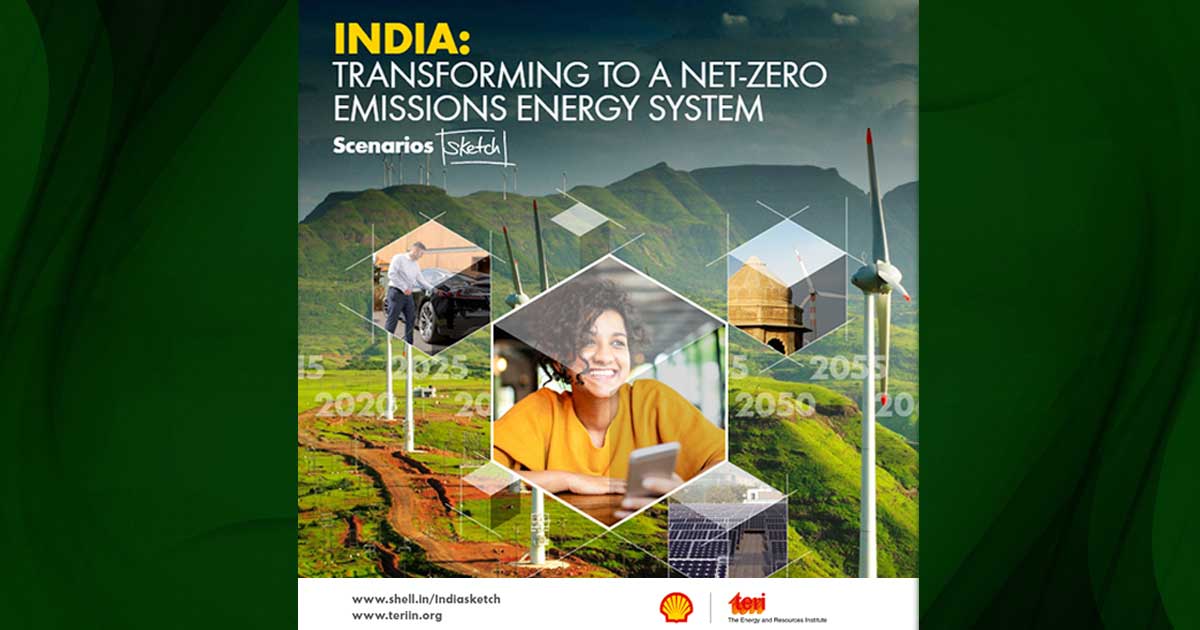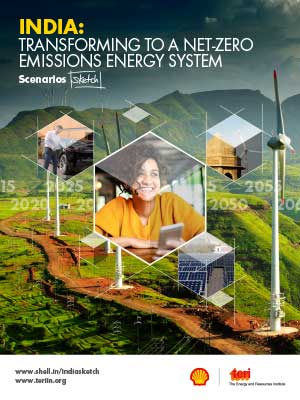Shell's energy transition pathways - model updation
The development and climate mitigation challenges before India raise questions about its energy pathways ahead. In this background, the broad objective of this project was to evaluate India's current options and limits across each of the energy sectors and sub-sectors towards examining the need for additional technology and policy options in moving towards a net-zero emissions energy system by 2050.
India: Transforming to a net-zero emissions energy system - Scenarios Sketch
This sketch illustrates a technically possible, but highly challenging pathway to steer domestic energy system towards net-zero emissions by 2050, while achieving India's economic development ambitions

Energy is at the heart of economic development and perhaps no country is more challenged by that association than India as it strives to create a better life for its population of almost 1.4 billion people. But how can India accomplish this and make progress towards reaching a net-zero emissions economy by 2050 in support of broader well-being?
This scenario sketch explores the on-going development of the Indian economy and its energy transition, taking into consideration the government's goals of significant economic growth, universal electricity access and clean cooking for all.
Each of these goals requires significant industrial capacity to achieve and, unless carefully managed, has the potential to increase greenhouse gas emissions. This sketch illustrates a technically possible, but highly challenging pathway to steering the domestic energy system towards net-zero emissions by 2050, while achieving India's economic development ambitions.
Today, greenhouse gas emissions have become central to any discussion on energy system choices and technological progress has brought to the fore an increasing number of fuel and technology alternatives that can be adopted at a commercial scale. Furthermore, the pressing need of eliminating dependence on fossil fuels is now recognised globally. There is an increased emphasis on innovative policies to avoid even greater dependency on fossil fuels in the future and ensure long-term sustainability.
Against this setting, it is an opportune time for India to re-evaluate its energy strategy and examine the choices, opportunities and risks across the energy sector. In this sketch, TERI and Shell have evaluated India's current options and limits across each of the energy sectors and sub-sectors and assessed the technology and policy options that can help the country accelerate towards the goal of net-zero emissions by 2050.
In this collaboration, TERI and Shell have developed a Net-Zero Emissions (NZE) scenario, the principle focus of this publication, to examine whether adequate opportunities exist to fully decarbonise the energy sector. The sketch also highlights the areas where India's energy sector does not have enough choices for full decarbonisation by 2050. From a second scenario, Towards Net-Zero (TNZ), we highlight barriers to change that might emerge.
Energy efficiency, electrification, and a switch towards decarbonised fuels are the three main pillars of India's energy strategy, with the need for a transformative move towards renewable electricity, hydrogen, and bioenergy as key fuels. This analysis indicates that the industrial and heavy transport sectors are likely to face limits in achieving full decarbonisation, primarily due to technological constraints which leave residual emissions in the system. This necessitates the need for carbon removal options to achieve net-zero emissions, including both technical and natural solutions.
This report is a comprehensive assessment of a net-zero emissions strategy for India's energy system. It is hoped that findings from this study encourage further deliberations on energy sub-sectors that could benefit policymakers and planners in charting India's sustainable energy transition.
Below are key elements from the pathway that the sketch suggests for India to achieve net-zero emissions from its energy system -
- Increase the generation of electricity fourfold from 2,000 terrawatt-hours (TWh) in 2020 to nearly 9,000 TWH in 2050, and raise electricity's share of final energy from 18% today to 45% in 2050
- Shift the electricity mix from about 65% generated by fossil fuels in 2020 to almost 90% generated by wind and solar in 2050; phase out coal by 2050, with some gas (up to 5% of generation) remaining
- Raise the share of hydrogen from negligible levels today to around 13% of final energy consumption in 2050, mainly as a fuel for industry and heavy-duty transport
- Increase the use of bio-resources (biomass and liquid biofuels) more than twofold, with residential biomass use declining and commercial biomass use (primarily in industry) increasing substantially to account for two-thirds of all uses by 2050
- Invest in infrastructure – particularly urban and industrial infrastructure – to reduce the energy intensity of the economy by around 50% between 2020 and 2050
- Establish significant carbon removal projects (using technology and nature) to achieve net-zero emissions in India's energy sector by 2050, primarily to capture residual emissions from hard-to-abate industries such as cement and to offset emissions from fast-growing sectors like aviation

